- Home
- Resurrection ▾
-
Learn ▾
- Free library
- Glossary
- Documents
- Initiation
-
Shaped fabrics
- Introduction
- Popularization
- Definitions
- Le métier de façonné
- Principes du façonné
- Mécaniques de façonné
- Le jeu des crochets
- Les cartons
- Chaîne des cartons
- Mécanique 104 en détail
- Pour en finir
- Montage façonné
- Empoutage 1/3
- Empoutage 2/3
- Empoutage 3/3
- Punching, hanging and dip
- Autres façonnés
- Façonnés et Islam
-
Cours de tissage 1912
- Bâti d'un métier
- Le rouleau arrière
- Les bascules
- Formation du pas
- Position de organes
- Mécanique 104 Jacquard
- Fonctionnement 104
- Lisage des cartons
- Le battant du métier
- Le régulateur
- Réduction et régulateur
- Mise au métier d'une chaîne
- Mise en route du métier
- Navettes à soie
- Battage
- Ourdissage mécanique
- Préparation chaînes et trames
- Equipment ▾
- Chronicles ▾
- Fabrics ▾
- Techniques ▾
- Culture ▾
- Language ▾
When a sufficient length is woven, the warp will be loosened, all the locks will be cut at the beginning of the weaving and the weaning (cloth) removed. In the groove of the front roller, the composter integrated into the weave will be inserted in the groove and locked in the groove. The weaving will then begin in reality.
We weave a few centimeters with a rather large weft as follows: a few frames are passed one after the other without being packed, just approached one another. When about ten frames have thus passed, one weaves a few frames by tamping them firmly and one repeats these operations a few times. This has the effect of regulating the tension of all the wires of the chain. Normally we weave a dozen centimeters and we pass a new composter in the crowd and we take back a normal weaving.
The fabric is wound one turn around the front roller. The other end of the coincidence also receives a composter slid into the hem. Buttonholes are spread on the canvas just at the hem, behind the composter. They are placed every 3 or 4 cm. The end of a string is firmly attached to the composter by passing it through the first buttonhole, the one on the left. Using a large needle, the string is passed through the needle between the 2 knots of the first wick and then behind the composter through the next buttonhole. This is done for all the wicks. Finally, the string is fastened to the last eyelet as for the first. The roller is wound slightly before the chain is tightened and the twine is allowed to regulate the tension of all the locks which assume an equal tension and weaving begins.
The front roll (here covered with a canvas) has a groove along its entire length, about 1 cm wide and about 1.5 cm deep. A fabric of a length of about 1 meter is used. This canvas ends at each end with a hem of one cm in which a composter is slid which is a simple round iron rod with a diameter of about 1 cm and a length equal to the width of the canvas. This painting bears the name of Egancette. The nozzle is inserted into the groove of the front roller and locked with nails that are bent after being pushed in with a small hammer.
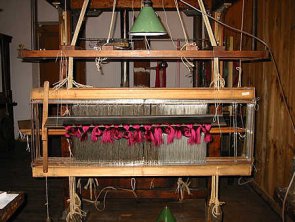
Once the stitching has been completed, the sash and front roller must be fitted. Once the leaf is suspended, the comb is detached and placed in the leaf. Then we break the provisional node of each strand of wires and replace it with 2 final nodes spaced 2 cm apart so that the nodes of all the strands are at the same level.
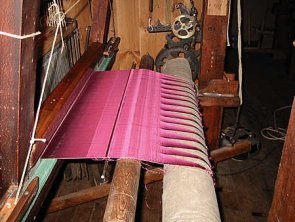
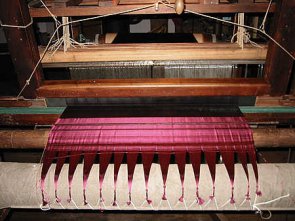
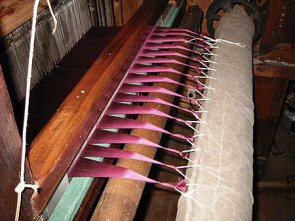
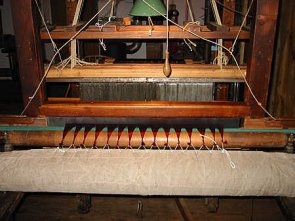
Getting Started
The start-up of the loom is the operation of preparing the loom and starting it.
